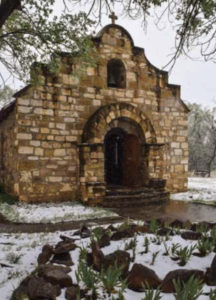A Year of Abundance: Sites Enjoy Renewal and Repair

Historians and other researchers studying New Mexico’s rich history and diverse cultures turn to primary sources, such as documents or artifacts, that provide direct evidence of their subject.
As places where history happened, each of the eight New Mexico Historic Sites serves as a stellar example.
In fiscal year 2021-2022 (July 1, 2021 to June 30, 2022), the Bosque Redondo Memorial at Fort Sumner Historic Site strengthened its story as it debuted its new permanent exhibition, Bosque Redondo: A Place of Suffering, A Place of Survival, on May 28, 2022.
Designed in partnership with with Navajo Nation and Mescalero Apache tribe, the exhibition uses state-of-the-art technology to tell the story of the Long Walk, one of the most tragic events in this country’s history, when thou- sands of Navajo (Diné) and Apache (N’de) were forcibly removed from their homelands to inhospitable land in central New Mexico. The memorial and its exhibition provide witness to this history.
The exhibition opening drew hundreds to the site for speeches, food, music, Native dance performances, children’s activities and Native art. The reimagined display and public outreach programming were funded in part by a previous grant via the Museum of New Mexico Foundation from the National Endowment for the Humanities. That $150,000 matching challenge grant generated $300,000 for the project over several years.
Private gifts in FY22 through the Foundation’s Exhibitions Development Fund generated an additional $2,545 for exhibitions at all of the sites, while the Education Fund drew $5,745. A total of $43,244 was raised in private support for the division.
Planting and Preserving
FY22 could have easily been called “The Year of the Garden” as several sites statewide exercised their green thumb. Los Luceros Historic Site, a 148-acre ranch on the Río Grande just north of Española, engaged local farmers to help prepare and plant the fields with corn, winter wheat, watermelon, pumpkins, carrots and beans.
Also located on the banks of the Río Grande, just north of Albuquerque, Coronado Historic Site debuted a redesigned interpretive garden inspired by traditional Indigenous waffle gardens and raised-row gardens. The “Three Sisters,” a traditional Native American companion planting method of corn, beans and squash, flourished along with amaranth, cotton and other traditional Pueblo crops. The newly created interpretive garden at Jemez Historic Site, located in the village of Jemez Springs, also featured an abundance of traditional Pueblo crops.
Meanwhile, FY22 allocations from the New Mexico State Legislature and dedicated site Friends groups helped keep historic site structures—and the memories they hold—in repair and open to the public.
At Lincoln Historic Site, a town preserved as it was in 1880, phase one of the Tunstall Store’s preservation was success- fully completed. This included foundation repairs, window and wood treatments and the humane removal of Mexican Freetail and Pallid bats who had made the building’s attic their home. The building re-opened to the public in the spring of 2022.
Some of Fort Stanton Historic Site’s 88 buildings date to 1855. Roofs on the Barracks, Fire House and Chapel were repaired in FY22, while mold mitigation took place in the Nurses’ Quarters. The site’s water system was also completely refurbished.
The central parade ground at Fort Selden, an adobe garrison of 20 buildings, had its irrigation system upgraded and new gravel pathways installed. And at the Taylor-Mesilla Historic Property, where resident Foundation donor J. Paul Taylor turned 102, installation of a much-needed HVAC system helped stabilize the home’s interior temperatures and preserve priceless art and furnishings.
Finally, modernization and technology added to the visitor’s experience at various sites in FY22. Upgrades included touchscreens at Bosque Redondo Memorial, downloadable self-guided tour apps at Los Luceros and Jemez, and newly installed interpretive signage at Coronado.
To support the New Mexico Historic Sites, contact Yvonne Montoya at 505.216.1592 or Yvonne@museumfoundation.org.
This article and image are from the Museum of New Mexico Foundation’s Member News Winter 2022. Image of the roof on the chapel at Fort Stanton Historic Site was repaired in FY22. Photo © Kenneth Walter.


Connect